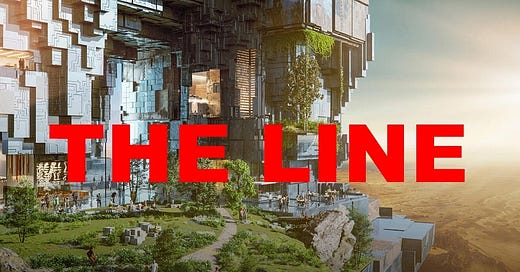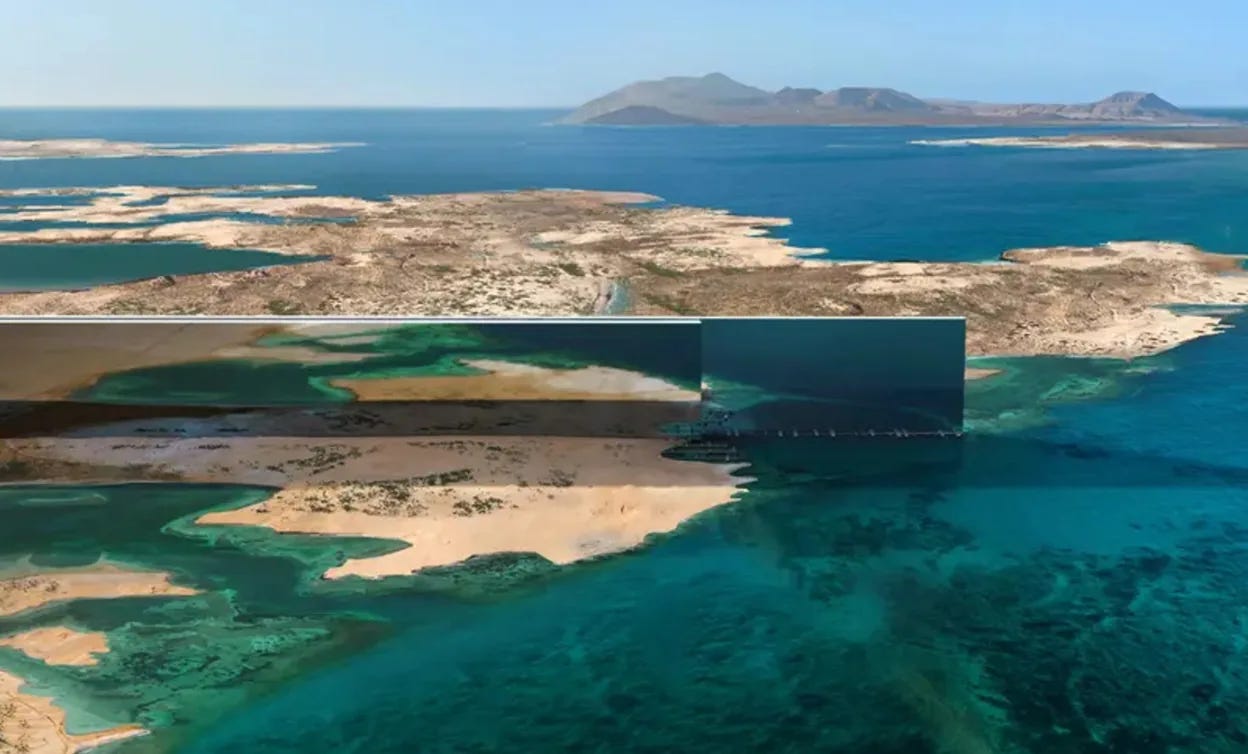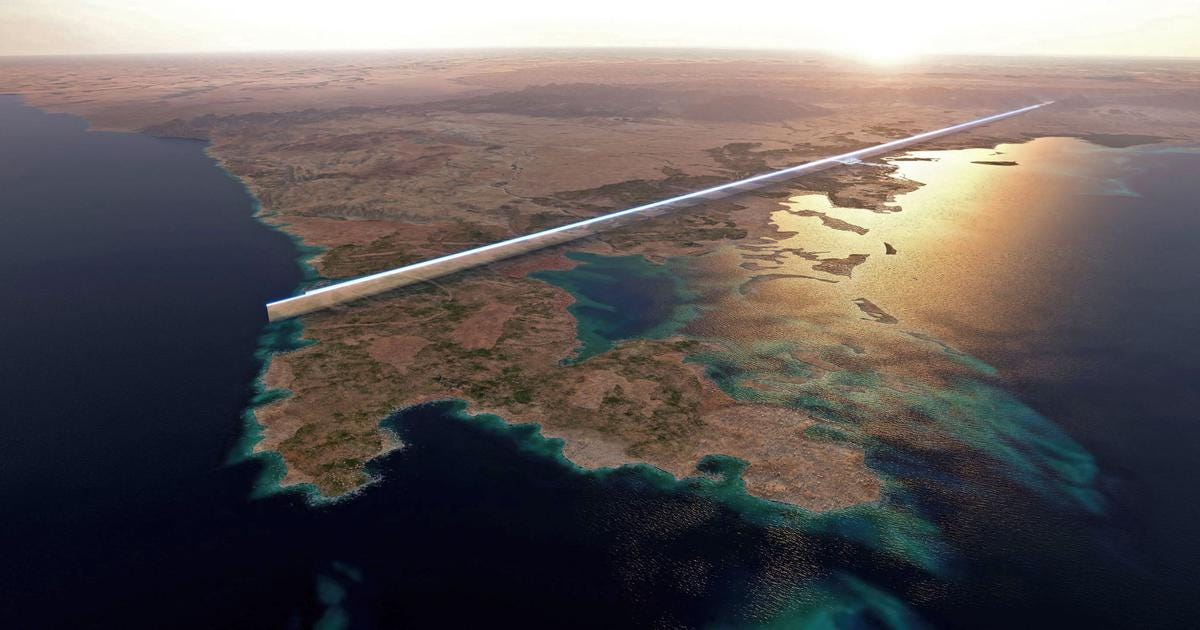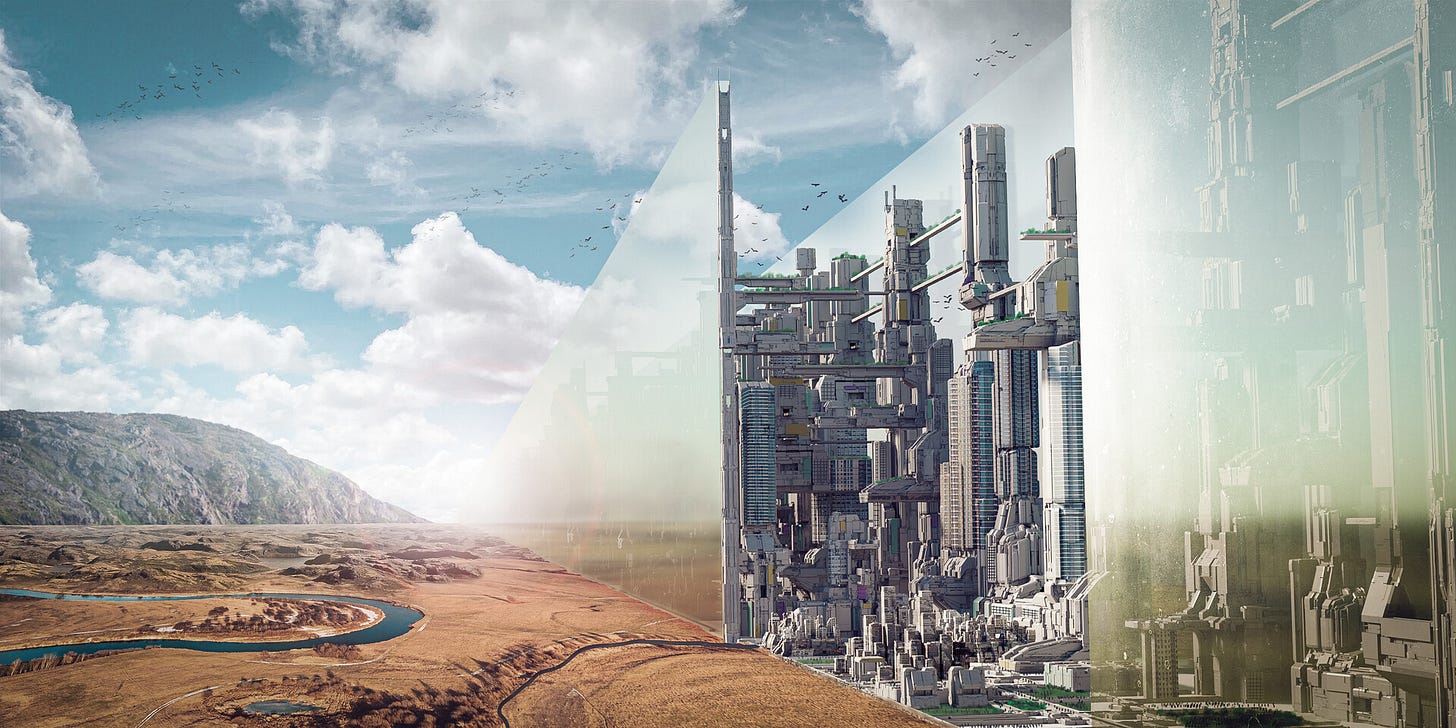What to do when you have so much dirty oil money you run out of things to spend it on? You build a 170 kilometre long, futuristic linear city that will be the envy of the world.
The Line is part of Saudi Arabia’s Vision 2030 project. It will be one continuous structure stretching from Neom, on the Red Sea to the inland city of Tabuk. The Line will be 200 metres wide and 500 metres high with an entirely mirror glass exterior. The car-free city will be large enough to house nine million residents, a quarter of Saudi’s population within walkable communities. A high-speed train will travel the 170-kilometre length in 20 minutes.
Construction started in 2022 with an estimated building cost of US$100–200 billion although some estimates predict costs could blow out to US$1 trillion. Money is no problem for the Saudi regime though.
The city will be powered entirely by renewable energy. Artificial intelligence will monitor the city and use predictive algorithms and data models to find ways to improve daily life for its citizens. Residents will be paid for submitting their personal data to The Line AI. I’m not sure if this is a utopian dream or dystopian nightmare.
It is estimated that 20,000 people are being forced to relocate. The indigenous nomadic Huwaitat tribe have already been displaced and three of them were sentenced to death when they refused to vacate their village. The disruption to migration patterns of birds and wildlife in the area were also ignored. These obstacles are trivial concerns for the powerful Saudi regime that were never going to let a few birds or nomads stand in the way of such a gargantuan vanity project.
Neom city is being built from the ground up as a ‘living laboratory’. The city will include the offshore Oxagon, a floating industrial complex in the shape of an octagon. Trojena, an outdoor snow and ski field with a folding vertical village and Sindalah, a gigantic luxury resort complex off the coast. It will be 33 times the size of New York City. Neom city’s vision describes “a new way of life from birth to death reaching genetic mutations to increase human strength and I.Q.,” This sounds suspiciously like a eugenics experiment and I have no idea what a folding vertical village will look like either.
Cloud-seeding will bring rain to the desert. Desalination, alternative energy and desert agriculture will apparently transform the arid land into a green paradise. Super-high-speed trains, robotic maids, Volocopters, snowfields and beaches with glowing sand are all part of the plan. Neom city head of tourism Andrew McEvoy said Neom would be treated as its own state, separate from the rules that govern the rest of Saudi Arabia. McEvoy told The National newspaper that people living in Neom would not be referred to as Saudis but would be called by the title “Neomians”.
To most of us interested observers, Saudi Arabia looks like a ridiculously rich medieval kingdom where women struggle for basic rights, bearded clerics run the courts and criminals are regularly beheaded by sword in public executions. Saudi Arabia was a relatively poor country until black gold was discovered in 1938. The instant wealth after the 1973 Yom Kippur war accelerated ambitions, and now the Crown Prince and Prime minister Mohammed bin Salman is intent on transforming his country from a dusty Arab state to a technocratic dictatorship. He is also conveniently the head of the Saudi sovereign wealth fund whose oil-stained riches seem to be bottomless.
His style of dictatorship has allowed the regime to restrict Saudi Arabia’s religious establishment, muffling the Islamist doctrine to make it more palatable for investors. He has funded various sportswashing enterprises and is relaxing the rigid constraints on cultural life. He is immensely popular in Riyadh, especially among young men. Women’s rights are still trampled upon, and the Crown Prince continues to harass and jail his critics as if the Jamal Khashoggi murder never happened.
Some Saudi journalists have criticised Vision 2030, emphasising the need to support and invest in existing towns before throwing billions into this glittering megalopolis. Khashoggi suggested as much in a column written a few months before he was murdered.
When launching the Vision 2030 project, without any apparent hint of irony, the Crown Prince said “by 2050, one billion people will have to relocate due to rising CO2 emissions and sea levels. 90% of people breathe polluted air. Why should we sacrifice nature for the sake of development? why should seven million people die every year because of pollution?”
Saudi Arabia is the world’s leading oil exporter, supplying fuel for the world’s biggest polluters. The Crown Prince made an appearance at the recent COP28 conference to block any potential deals to end fossil fuel production. The Line is being constructed as a place where climate change can be ignored. A glittering mirror-glass mirage in complete contrast and defiance of the environment.
The Saudi regime is spending tens of billions of dollars to try to diversify their economy, investing in industries like renewable energy, tourism, entertainment and artificial intelligence. But such rapid expansion and diversification is expensive. The regime is dependent on their massive oil revenues to fund their plans for life after oil. Life on The Line.
Neom city and The Line will be built by, and on the bones of, tens of thousands of migrant workers. According to Human Rights Watch, millions of migrant workers fill mostly manual, clerical, and service jobs in Saudi Arabia. More than 80% of the private sector workforce are from India, Sri Lanka, Philippines and Nepal. The kafala system of enslaved workers requires migrants to have a sponsor, usually their employer, who is responsible for their visa and legal status. The kafala system leaves workers open to exploitation, as many employers take away passports and abuse their workers, forcing them to pay off enforced debt with no chance of legal repercussions.
The bold statements on the impressive websites contain a lot of grand hyperbole. “All energy in Neom will be 100 per cent renewable, from solar, wind and hydrogen-based power generation. Ensuring a zero-emission, carbon-positive ecosystem. The city will preserve 95 per cent of the natural environment around the site, highlighting mankind's relationship with the natural world. Neom will be a layered city functioning vertically, giving people the possibility of moving seamlessly in three dimensions. A concept referred to as zero-gravity urbanism.”
Also proposed for Neom is a $5 billion enterprise to produce 650 tonnes of green ammonia for hydrogen fuel every day by 2025, which will be available for global export. If it eventuates, this will signal a profound change of direction away from the oil fields but is it the world’s largest green hydrogen project? Or the world’s largest greenwashing project.
Most of the funding for the construction of The Line comes from profits from the Saudi fossil fuel industry and the claims of The Line running sustainably ignore the vast energy and resources required for construction. And imagine the energy needed to maintain a season defying ski field in the desert. Critics outside of the regime have described the entire project as an expensive distraction so the nation can continue to increase fossil fuel production.
These artistic predictions of what Neom city and The Line will look like are wild. Something a sci-fi obsessed AI image generator on acid would create. I love good sci-fi, and I love the idea of the Earth’s population living in beautiful, efficient, sustainable, no impact cities with abundant natural space around them so the wild can be wild. I love the aspiration of empathetic AI working with humanity to build a better future. I also like the sound of zero-gravity urbanism.
But I would prefer cities that aren’t built with petrodollars on the bones of migrant workers as a giant greenwashing sideshow. This Saudi vision of horizontal glass skyscrapers in the desert would be a perfect end-of-days place for the rich to escape to as the world burns. The Line has an ambitious completion date of 2025. Just in time for the climate apocalypse.









